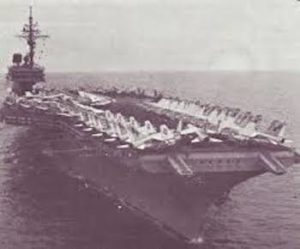
USS Kitty Hawk
*On this date in 1972, The USS Kitty Hawk Riot occurred.
This was a racial conflict between white and Black sailors aboard the United States Navy aircraft carrier Kitty Hawk that night while positioned at Yankee Station off the coast of North Vietnam during the Vietnam War. In the early days of the Vietnam War, black service members represented less than 5% of the Navy.
By 1971, after President Nixon sought to remake the military into one of all volunteers, and the U.S. was beginning to disengage from Vietnam, the number of men drafted dramatically decreased, and the demand to join the Navy decreased. The Navy recruitment quota fell by more than 50% from 1971 to 1972, which resulted in the Navy needing Black men to achieve its recruitment goals. Blacks joined rapidly, increasing their overall representation to 20%. Under the Navy's tradition of Southern white leadership, racial bias, and low test scores, Blacks spent more time assigned to the least desirable, most difficult, and least dignified jobs. In contrast, whites were routinely promoted to the most desirable and respected jobs, accounting for 99% of the Navy's officers.
Early that evening, 18-year-old Black Airman Apprentice Terry Avinger wanted two sandwiches; he was told by a white mess cook that he was only allowed one. The Black sailor reached across the food line and grabbed an extra sandwich; a shouting match ensued. A series of happenings led to the worst shipboard riot in U.S. Navy history. “The ship of 4,500 sailors, with only 302 being Black, erupted into chaos when angry Black sailors roamed the ship’s passageways, beating white sailors with makeshift weapons such as broom handles, wrenches, and pieces of pipe.
By the next day, over 50 sailors, nearly all white, were injured, some severe enough to be evacuated from the ship to onshore hospitals. The fallout would see several black sailors disciplined for the incident.” Six weeks after the incidents, the Kitty Hawk returned to San Diego, where 27 Black sailors were arrested and charged. No white sailors were arrested.
Twenty-one of those charged requested a court-martial trial. Lawyers for the black sailors stressed the bias shown in the pre-trial report against their clients, stating that it only contained testimony from prosecution witnesses. Congress was investigating the incident by December and called Townsend and Cloud to testify. Most of those who requested a court-martial were also invited to testify, but they all declined, and no subpoenas were issued to force them to do so. In January 1973, before a Navy court-martial, Commander Ben Cloud testified that the fighting erupted when Marines, on orders to break up groups of three or more sailors, only enforced the order against groups of Black sailors.
He further testified that he had been threatened by black and white sailors alike. During the fighting between Black sailors and Marines, he witnessed a white sailor seemingly directing Marines toward black sailors. He noted that Captain Townsend requested that the white sailor be identified, "but this was not done." In February, on behalf of 17 Black sailors, the NAACP brought a complaint against a prosecutor for racial prejudice to get the charges against the Black sailors dismissed.
The complaint was also against Michael A. Laurie, a white sailor who had been a key government witness for perjury, after tape recordings surfaced of Laurie admitting that white sailors had "exaggerated" about the violence of Black sailors, then later affirming that he had lied about Black sailors when he was asked outright. Laurie elaborated that, despite not seeing any Black sailors hit any white sailors, white sailors would say they did. Laurie also doubted his integrity and demonstrated racist leanings when he expressed his regret for not having a gun that night since it would have allowed him to have killed "at least 30 of them [niggers]." In April 1973, the courts-martial concluded with a total of 27 trials.